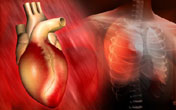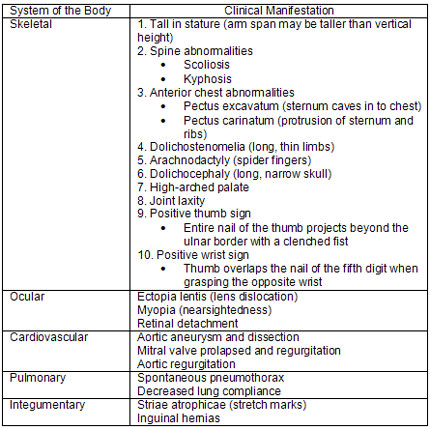Introduction
 Marfan
syndrome is a genetic disorder of connective tissue that is mainly
manifested by cardiovascular complications with certain
characteristic skeletal components. The incidence rate of Marfan
syndrome is estimated to be between 1 in 3,000 to 10,000 individuals
worldwide (1). There are varying degrees of
severity of Marfan syndrome and if diagnosed and treated properly, a
normal life expectancy can be achieved. If an individual with Marfan
syndrome is asymptomatic, the diagnosis can often be overlooked by
health care professionals. Therefore, physical therapists can play
an important role in recognizing risk factors in children with
Marfan syndrome and educate the family as well as other health care
professionals about the disease. This article will identify key
components of Marfan syndrome as they relate to physical therapy
practice. Clinical manifestations of Marfan syndrome will be
identified as well as medical management and physical activity
precautions for individuals with Marfan syndrome. Marfan
syndrome is a genetic disorder of connective tissue that is mainly
manifested by cardiovascular complications with certain
characteristic skeletal components. The incidence rate of Marfan
syndrome is estimated to be between 1 in 3,000 to 10,000 individuals
worldwide (1). There are varying degrees of
severity of Marfan syndrome and if diagnosed and treated properly, a
normal life expectancy can be achieved. If an individual with Marfan
syndrome is asymptomatic, the diagnosis can often be overlooked by
health care professionals. Therefore, physical therapists can play
an important role in recognizing risk factors in children with
Marfan syndrome and educate the family as well as other health care
professionals about the disease. This article will identify key
components of Marfan syndrome as they relate to physical therapy
practice. Clinical manifestations of Marfan syndrome will be
identified as well as medical management and physical activity
precautions for individuals with Marfan syndrome.
Marfan syndrome can be somewhat difficult to diagnose due to the
commonality of some of the clinical manifestations. Currently, the
diagnosis of Marfan syndrome is based off of criteria known as the
Ghent nosology that was defined in 1996 (2). Figure 1
from Dean’s article published in the European Journal of Human
Genetics is an algorithm that can help differentially diagnose Marfan syndrome from other related disorders. Although family
history is helpful in ruling in Marfan syndrome, around 27% of the
cases arise from a new genetic mutation of chromosome 15 (2). Marfan’s syndrome does not discriminate against races
or ethnic groups and occurs equally in males and females (3). Women with Marfan’s syndrome have a 50% chance of
passing the genetic disease on to their children with every
conception (1). It is suggested by Dean that
clinical evaluations should be completed periodically in children
with suspected Marfan disease until the child reaches 18 years of
age (2). The evaluation should pay close attention to
family history, the cardiovascular, ocular and musculoskeletal
systems.

The physical manifestations of Marfan syndrome are widespread
throughout the body due to the importance of connective tissue in
most of our systems. Table 1 displays the most common clinical
manifestations that may be present in an individual with Marfan
syndrome based on the body system involved.
Table 1. Signs of Marfan syndrome (adapted from the text of
Braverman, 1998)

Not all of the manifestations need to be present for diagnosis, but
if Marfan syndrome is suspected in an individual; it is necessary to
refer to the proper health care professionals for further testing.
Children and teenagers that do not know they have Marfan syndrome
may unknowingly participate in activities and sports that could put
them at a huge cardiovascular risk for aortic dissection and sudden
death (4). Therefore, it is increasingly important to make sure
Marfan’s syndrome is ruled out in suspected cases. Cardiovascular
complications are the most severe manifestations of the disease and
may lead to severe morbidity and mortality (3).
Medical treatment of Marfan syndrome varies with the extremes of
clinical manifestations. Surgical management proves to be an
effective solution to the cardiovascular complications of Marfan
syndrome. Aortic root dilatation and mitral regurgitation are common
surgical indications in children with Marfan’s syndrome (5). Left
untreated, these cardiovascular manifestations lead to early
mortality in individuals with Marfan disease accounting for 80% of
premature deaths (5). Screening for cardiovascular manifestations is
important and improved technology, such as the use of
echocardiograms, allows medical professionals to properly diagnose
and treat the underlying problems. With advanced surgical
techniques, cardiovascular problems can be corrected in children
thus increasing life expectancy and quality of life in those
individuals. Numerous studies have indicated that prophylactic
cardiac surgeries have increased survival rates when compared to
emergency surgeries for individuals with Marfan syndrome (2). The
primary morbidity from operations in children with cardiovascular
issues is the need for second cardiac procedure within 10 years (5).
Although surgical techniques are more efficient when done
prophylactically , people with cardiovascular complications of
Marfan syndrome need to be managed with oral medications as well.
Beta-adrenergic drugs such as metoprolol, atenolol and propranolol
help reduce the rate of aortic dilatation in children with Marfan
syndrome (6). Beta blockers help to increase aortic distensibility
and reduce aortic stiffness and pulse wave velocity, thus delaying
and perhaps preventing dilatation and dissection of the aorta (6).
Beta blockers and calcium channel blockers are both effective in
decreasing the contractility of the heart and reducing the heart
rate to prevent any further damage (1). If beta blockers are not
tolerated by the patient, blood pressure can be reduced by using
angiotension-converting enzyme (ACE) inhibitors that decrease
peripheral resistance to blood flow (1). It is important for
individuals with Marfan syndrome to be compliant with their
medications to decrease the risk of aortic dissection.
Exercise and physical activity are important components in the
treatment and management of individuals with Marfan syndrome.
Regular physical activity benefits all systems of the body by
increasing bone mineral density, lean body mass and overall fitness
leading to an increased life expectancy and quality of life. It is
important to monitor activity levels of people with Marfan syndrome
as they are prone to life threatening cardiovascular complications
if the intensity of the exercise is too much for their
cardiovascular system to handle. High intensity exercise, isometric
activities and contact sports should be avoided in favor of walking,
hiking, swimming and cycling to decrease the risk of aortic
dilatation and dissection (1). Moderate activity exercise has been
shown to safely increased heart rate, stroke volume and cardiac
output while decreasing peripheral resistance, thus still achieving
a cardiovascular response (1). Heart rate monitoring may not always
be an accurate measure of cardiovascular response for individuals
with Marfan syndrome due to the widespread use of heart rate
reducing medications such as beta blockers.
Decreased oxygen also increases the need for proper education and
appropriate exercise programs for individuals with Marfan syndrome.
Pulmonary function training of young adults with Marfan syndrome
using spirometry indicated a 30-50% reduction in peak oxygen uptake
compared to a healthy population (1). This deficiency is possibly
due to decreased elasticity of lung tissue. Due to this lung
compliance issue, it is recommended that individuals with Marfan
syndrome should not exceed 50% of their aerobic capacity during
activity (1).
Cardiovascular and pulmonary functions are just two of the skeletal
issues we need to be aware of in the physical therapy setting as we
are prescribing exercise to patients’ with Marfan syndrome. Back
pain due to kyphosis or scoliosis and joint laxity are also common
concerns with Marfan syndrome and may lead the primary care doctors
to refer these individuals to physical therapy (4). Interventions
for back pain and joint laxity due to Marfan syndrome are similar to
interventions for healthy individuals with the same problems.
Treatment should focus on pain management as well as strengthening
specific muscle groups to help stabilize joints and education to
avoid end ranges of motion of lax joints. Axial abnormalities cannot
be corrected by physical therapy, but strengthening of muscle groups
can help maintain a more upright posture and decrease functional
scoliosis (1).
Recognizing signs of Marfan syndrome is an important aspect of
physical therapy practice especially if you are working with
pediatrics and high school age children. It is possible that
children will go undiagnosed with Marfan syndrome if they are
asymptomatic and a sports injury could lead them to initially start
attending physical therapy sessions. If signs of Marfan syndrome are
recognized, it is important to refer to the correct health care
professional for further testing to prevent associated
complications. If not properly treated, premature death may be
caused by the severe cardiovascular and pulmonary complications
associated with Marfan syndrome.
Last revised: September 14, 2010
by Sarah Bellin, DPT
References:
1) Dennison A & Certo C.
Exercise for individuals with marfan syndrome. Cardiopulmonary Physical
Therapy Journal. 2006;17(3):110-115.
2) Dean J. Marfan syndrome: Clinical diagnosis and management. European
Journal of Human Genetics : EJHG. 2007;15(7):724-733.
3) Amado J & Thomas D. Continuing education. Early recognition of marfan's
syndrome. Journal of the American Academy of Nurse Practitioners.
2002;14(5):201-206.
4) Braverman A. Exercise and the marfan syndrome. Medicine and Science in
Sports and Exercise. 1998;30(10 Suppl):S387-95.
5) Gillinov A, Zehr K, Redmond J, Gott V, Deitz H, Reitz B, et al. Cardiac
operations in children with marfan's syndrome: Indications and results. The
Annals of Thoracic Surgery. 1997;64(4):1140-1145.
6) Dean J. Management of marfan syndrome. Heart. 2002;88(1):97-103.
|


 Marfan
syndrome is a genetic disorder of connective tissue that is mainly
manifested by cardiovascular complications with certain
characteristic skeletal components. The incidence rate of Marfan
syndrome is estimated to be between 1 in 3,000 to 10,000 individuals
worldwide (1). There are varying degrees of
severity of Marfan syndrome and if diagnosed and treated properly, a
normal life expectancy can be achieved. If an individual with Marfan
syndrome is asymptomatic, the diagnosis can often be overlooked by
health care professionals. Therefore, physical therapists can play
an important role in recognizing risk factors in children with
Marfan syndrome and educate the family as well as other health care
professionals about the disease. This article will identify key
components of Marfan syndrome as they relate to physical therapy
practice. Clinical manifestations of Marfan syndrome will be
identified as well as medical management and physical activity
precautions for individuals with Marfan syndrome.
Marfan
syndrome is a genetic disorder of connective tissue that is mainly
manifested by cardiovascular complications with certain
characteristic skeletal components. The incidence rate of Marfan
syndrome is estimated to be between 1 in 3,000 to 10,000 individuals
worldwide (1). There are varying degrees of
severity of Marfan syndrome and if diagnosed and treated properly, a
normal life expectancy can be achieved. If an individual with Marfan
syndrome is asymptomatic, the diagnosis can often be overlooked by
health care professionals. Therefore, physical therapists can play
an important role in recognizing risk factors in children with
Marfan syndrome and educate the family as well as other health care
professionals about the disease. This article will identify key
components of Marfan syndrome as they relate to physical therapy
practice. Clinical manifestations of Marfan syndrome will be
identified as well as medical management and physical activity
precautions for individuals with Marfan syndrome.






